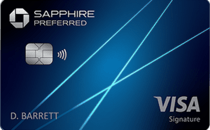Blue Cash Preferred Card from American Express vs. Chase Sapphire Preferred Card
The Blue Cash Preferred Card from American Express offers more than $450 in annual rewards value. It has a 0% introductory APR on purchases for the first 12 months, then an APR of 13.99% to 23.99% variable. The card is a good choice if you’re looking for everyday rewards and want to save on interest for the first year.
The Chase Sapphire Preferred Card has a better sign-up bonus, and it allows you to transfer points for their full value to travel partners. Though the two cards have close to equal value, if you want a flexible travel rewards card, the Chase Sapphire Preferred Card can provide great value even if you’re not using the points for travel.
If you plan on doing a lot of traveling, Chase Sapphire Reserve offers the most benefits in that category, including larger bonuses for travel expenses and better perks while you’re on the road.
However, Chase Sapphire Preferred Card offers the same value for its sign-up bonus and still features decent travel perks and flexibility on where you spend your points. Couple that with its much lower annual fee, and it may prove more attractive if you stay closer to home.
The American Express Gold Card offers high rewards rates on restaurant and U.S. supermarket purchases. Plus, cardholders can transfer points to airline and hotel partners. This card offers the same sign-up point bonus but allows cardholders six months to earn it versus Chase Sapphire Preferred Card’s three-month window.
The Chase Sapphire Preferred Card offers great potential for rewards in the first year, and it has the ability to transfer points for their full value to travel partners. If you want a flexible travel rewards card, the Chase Sapphire Preferred Card can offer value. Users may appreciate this card’s lower annual fee compared with the American Express card.
Earning Rewards with the Chase Sapphire Preferred Card
Approximate annual rewards value: $285
Sign-up bonus value: $1,250
First-year rewards value: $1,035
The Chase Sapphire Preferred Card has a solid three points per dollar earning rate on dining purchases and two points per dollar on travel purchases. You’ll earn five points per dollar on Lyft rides through March 2022. All other purchases earn one point per dollar. That can make every trip you take count toward your next one. You can also earn up to $60 back on a Peloton membership through the end of 2021.
Even if you dine out more than you travel, restaurant purchases can add up to valuable travel rewards over time. But if you’re hoping to use the Chase Sapphire Preferred Card to turn a few thousand dollars in annual expenses into a getaway, the annual fee will overtake your rewards value before you’ve earned enough to go on your trip.
Other Travel Benefits
Trip cancellation and interruption insurance covers up to $20,000 per trip. Flight delay reimbursement is worth up to $500 per ticket. Also included is auto rental collision damage waiver coverage.
How Much Can You Earn?
Based on average spending data from the federal Bureau of Labor Statistics, Chase Sapphire Preferred Card holders can earn an estimated 22,800 points each year. That’s worth $228 for most redemption options, or $285 in travel when you book with Chase Ultimate Rewards.
| Expenditure | Annual cost | Point per dollar earning rate | Annual points earned |
| Groceries (after April 30, 2021) | $4,400 | One | 4,400 |
| Dining | $3,400 | Three | 6,800 |
| Apparel and services | $1,800 | One | 1,800 |
| Flights and hotels | $1,000 | Two | 2,000 |
| Gas | $2,000 | One | 2,000 |
| Entertainment | $3,000 | One | 3,000 |
| Personal care products and services | $800 | One | 800 |
| All other expenditures | $2,000 | One | 2,000 |
| Total annual points earned | 22,800 | ||
| Total annual value when redeemed for travel | $285 |
Values for each spending category are based on average data from the 2017 U.S. Bureau of Labor Statistics Consumer Expenditure Survey. Each category is rounded to the nearest $100.
The card’s 100,000-point sign-up bonus can accelerate your earnings. You’ll need to spend $4,000 on purchases in the first 3 months from account opening to earn it.
A popular strategy for earning more rewards with the Chase Sapphire Preferred Card is pairing it with one or more of Chase’s no-annual-fee cards that earn bonus rewards in more categories than just dining and travel. You can transfer points value from these cards and redeem at the Chase Sapphire Preferred Card’s elevated travel rate.
For example, with the Chase Freedom Flex card, you can activate 5% cash back on the first $1,500 spent in rotating bonus categories each quarter. And the Chase Freedom Unlimited earns 1.5% cash back on all nonbonus category purchases, which can be transferred to your Chase Sapphire Preferred Card as 1.5 points per dollar.
How to Redeem Rewards
Redemption value is the Chase Sapphire Preferred Card feature that travel hackers obsess over. The card offers outsized value in Chase Ultimate Rewards travel booking and the potential for even greater value with travel partners.
Rewards are worth 25% more, at a value of 1.25 cents per point, when booking travel through Chase Ultimate Rewards, so redeeming your rewards this way is a no-brainer option for increasing their value.
But a Chase Ultimate Rewards travel booking might not be the card’s greatest redemption offer, as Chase’s travel partners could offer more valuable options. According to U.S. News research, multiple Chase travel partners redeem at an average rate higher than 1.25 cents per point:
| Chase travel partner | Average value of points or miles |
| British Airways Executive Club | 2.51 cents |
| Southwest Airlines Rapid Rewards | 1.37 cents |
| United Airlines MileagePlus | 1.69 cents |
| Virgin Atlantic Flying Club | 5.29 cents |
| World of Hyatt | 1.99 cents |
Though travel bookings with the Chase Sapphire Preferred Card can be both valuable and flexible, the bottom line is you don’t get absolute freedom booking travel with points from your Chase Sapphire Preferred Card. You’re limited to what’s available in the portal or with Chase’s travel partners, even if the selection is extensive. That’s not the case with some competitors, which offer miles you can redeem for a statement credit on any travel expense.
If you’re booking through Chase Ultimate Rewards, you may not be able to sync up with your travel loyalty program. For example, your hotel stay might not count toward the next status tier, and you might not be able to use any status perks you’d otherwise qualify for, like an upgraded room or free breakfast, because you didn’t book directly.
Can You Transfer Chase Sapphire Preferred Card Points?
For many partner frequent flyer programs, you can transfer points at a 1-to-1 ratio.
Airline transfer partners include:
- Aer Lingus AerClub
- British Airways Executive Club
- Emirates Skywards
- Flying Blue Air France KLM
- Iberia Plus
- JetBlue TrueBlue
- Singapore Airlines KrisFlyer
- Southwest Airlines Rapid Rewards
- United MileagePlus
- Virgin Atlantic Flying Club
Hotel transfer partners include:
- IHG Rewards Club
- Marriott Bonvoy
- World of Hyatt
APR
The Chase Sapphire Preferred Card may have enticing rewards and benefits, but the party’s over if you need to carry a balance. This is not a credit card you want to carry a balance on.
It doesn’t offer a 0% introductory APR on purchases or balance transfers, so you’ll pay interest on any balance you carry. The interest rate is slightly above average compared with other travel cards, according to U.S. News research, with a 15.99% – 22.99% Variable.
Chase Sapphire Preferred Card Annual Fee
The Chase Sapphire Preferred Card’s $95 annual fee can be a drawback, depending on your perspective. If you prefer cards with no annual fee, you might have a problem paying for one on this card.
If you’re considering premium travel cards with annual fees well into the triple digits, such as the Chase Sapphire Reserve, the Chase Sapphire Preferred Card’s annual fee is a bargain. However, premium travel cards may offer travel credits and greater rewards and benefits than you can get with the Chase Sapphire Preferred Card.
Another fee to consider: the foreign transaction fee. The Chase Sapphire Preferred Card does not have a foreign transaction fee, which means you won’t be subject to a 3% fee on purchases you make in a foreign country or currency. That can be handy if you’re planning a trip abroad.
Should You Get a Chase Sapphire Preferred Card?
- Can earn rewards at a value greater than $95 annually
- Plan to redeem rewards for travel expenses
- Don’t plan to carry a balance
- Want to take advantage of travel protections and no foreign transaction fee
Questions About the Chase Sapphire Preferred Card
Q: Is the Chase Sapphire Preferred Card worth It?
A: The Chase Sapphire Preferred Card is worth it for the typical consumer, as annual rewards earning outweighs its annual fee based on average consumer spending.
Q: What are the Chase Sapphire Preferred Card credit score requirements?
A: The Chase Sapphire Preferred Card requires good or excellent credit. You’ll need a FICO score of at least 670 to be approved for the Chase Sapphire Preferred Card.
Q: Is the Chase Sapphire Preferred Card the best credit card?
A: Though the Chase Sapphire Preferred Card offers good value for most consumers, it’s not necessarily the best card for you. Consider your credit score, typical spending, benefits and card costs when choosing the best credit card for your needs.
Q: How long does it take to get the Chase Sapphire Preferred Card?
A: It typically takes seven to 10 business days for a new Chase Sapphire Preferred Card to arrive after you’re approved. However, Chase may offer expedited one- to two-day delivery of your card upon request.







More News
First Federal Bank Mortgage Review
OneTrust Home Loans Review
Tapping Home Equity to Pay Your Bills: What You Should Know